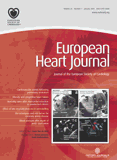-
PDF
- Split View
-
Views
-
Cite
Cite
E.A. Whitsel, T.E. Raghunathan, R.M. Pearce, D. Lin, P.M. Rautaharju, R. Lemaitre, D.S. Siscovick, RR interval variation, the QT interval index and risk of primary cardiac arrest among patients without clinically recognized heart disease, European Heart Journal, Volume 22, Issue 2, 1 January 2001, Pages 165–173, https://doi.org/10.1053/euhj.2000.2262
Close - Share Icon Share
Abstract
Aims Autonomic tone influences RR interval variation (RRV) and the heart rate-corrected QT interval index (QTI). Together, QTI and RRV may improve characterization of sympathovagal control and estimation of risk of primary cardiac arrest. We therefore examined effects of QTI and short-term RRV from standard, 12-lead electrocardiograms on risk of primary cardiac arrest among persons without clinically recognized heart disease.
Methods and Results We analysed data from a case-control study of risk factors for primary cardiac arrest among enrollees in a large health plan. Cases (n=505) were enrollees aged 18 to 79 years without history of heart disease who had primary cardiac arrest between 1980 and 1994. Controls (n=529) were a demographically similar, stratified random sample of enrollees. We determined enrollee characteristics from ambulatory medical records, QTI and RRV from standard, 12-lead electrocardiograms, and medication use from automated pharmacy files. Low and high values of QTI and RRV were designated as the first and fifth quintiles of QTI (96% and 107%) and RRV (35ms and 120ms) among controls. In a model adjusting for clinical predictors of primary cardiac arrest, RRV modified the association between QTI and risk of primary cardiac arrest (P=0·05). Compared to high RRV and low QTI, the risk of primary cardiac arrest (odds ratio [95% CI]) was 0·95 [0·73–1·23] at low RRV and QTI, 1·23 [0·97–1·57] at high RRV and QTI, and 1·55 [1·16–2·06] at low RRV and high QTI. Risk remained elevated after adjustment for other electrocardiographic predictors and medication use.
Conclusion Autonomic dysfunction, characterized by high QTI and low RRV on the standard, 12-lead electrocardiogram, is associated with an increased risk of primary cardiac arrest among persons without clinically recognized heart disease.
Correspondence: Eric A. Whitsel, MD MPH, University of North Carolina, Department of Epidemiology, Cardiovascular Disease Program, Bank of America Center, Suite 306, 137 East Franklin Street, Chapel Hill, NC 27514, U.S.A.
References
Task Force of the European Society of Cardiology and the North Ameican Society of Pacing and Electrophysiology, Heart rate variability, Standards of measurement, physiological interpretation, and clinical use, Circulation, 1996, 93, 1043, 65



